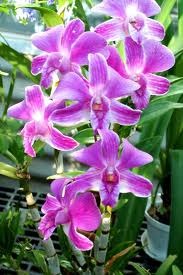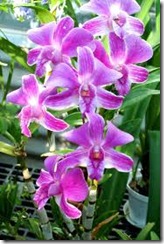Out of the over 20,000 different flowering plant species in the orchid family, Phalaenopsis, Cattleya and Dendrobium are the species best suited for growing in the home. Despite what you may have heard about orchids being high maintenance and hard to grow, they can actually be grown quite successfully and with few problems when provided with the appropriate cultivation requirements. Use these simple tips to overcome any problems that you may be having with your indoor orchids.
Potting Mix
-
Most of the orchids grown in the home are native to tropical and subtropical South America, where they are found growing on the sides of trees. These exotic and intriguing plants use modified aerial roots to absorb moisture and nutrients from their surroundings. When grown indoors, orchids must be potted in coarse potting mix to prevent their roots from suffocating due to lack of oxygen. Use a commercial orchid potting mix or combine equal parts sphagnum peat moss, redwood bark, cork, charcoal and volcanic rock to make your own. Plant orchids in well-draining planting containers at the same level they were growing in their garden center containers.
Sunlight
-
Orchids have very particular sunlight requirements and providing the incorrect amount of light may result in a plant that burns, wilts or fails to bloom. For best results, situate orchids in partial sun locations that receive bright, but indirect, sunlight for a minimum of four hours each day. The University of Tennessee recommends placing orchids on the windowsill of a window with a south, east or west exposure to ensure that they receive the sunlight necessary for healthy development.
Water
-
Knowing just how much water to provide for your orchids can be tough for first-time growers. Just Add Ice Orchids recommends watering orchids via the ice cube watering method to make weekly watering a little less stressful. Take three standard-size ice cubes and arrange them on the surface of the potting mix. As the ice cubes melt, the water will trickle through the potting mix to evenly hydrate the roots without drowning them. Avoid allowing orchids to sit in standing water to help prevent their roots from rotting.
Temperature and Humidity
-
Providing the correct indoor climate is essential to successful orchid cultivation. Attempting to grow orchids in an unsuitable environment can cause them to wilt, yellow or drop their leaves. To avoid temperature and humidity related orchid problems, set your thermostat to maintain a daytime temperature between 68 and 75 degrees Fahrenheit. Lower the temperature by 10 degrees at night to mimic the cooler nighttime temperatures that they would experience outdoors in their native climate. Orchids perform best in 50 to 70 percent relative humidity. The easiest way to raise the relative humidity to a level that is suitable for orchids is to run a cool mist humidifier in the room where they are kept.
Pests and Diseases
-
Even when grown indoors, orchids are susceptible to problems with a number of common insect pests and botanical diseases. Be on the lookout for pests such as aphids, mealybugs, thrips, spider mites, fungus gnats, snails and slugs. Pick the insects off the orchids by hand, as soon as you notice them. Swab the leaves with a cotton ball that has been dipped in rubbing alcohol to discourage future infestations. Treat affected orchids with a horticultural oil or insecticide if insect problems persist. Discolored flowers and dark, ringed spots on the foliage indicate that your orchids are suffering from a fungal disease; treat with a fungicide product to correct the problem.


Deprecated: strpos(): Passing null to parameter #1 ($haystack) of type string is deprecated in /home/agriviek8Qv/agriviet.net/public_html/wp-includes/comment-template.php on line 2522